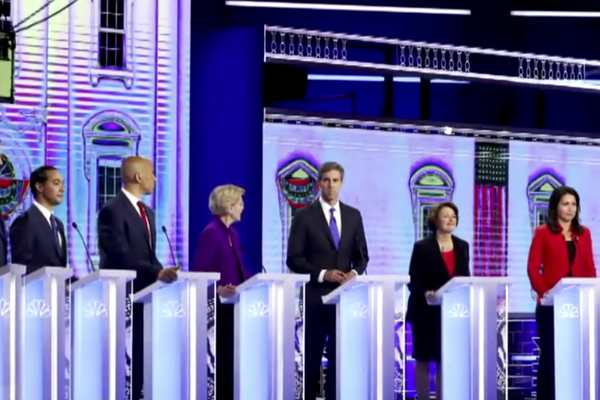The 2020 Election Presents a Unique Opportunity to Elect a “New Generation of Leadership”

The 2020 election presents a unique opportunity to elect a “new generation of leadership” to the presidency. The American public has done so before, as represented by John F. Kennedy in 1960; Jimmy Carter in 1976; Bill Clinton in 1992; and Barack Obama in 2008.
One way to elect a “new generation of leadership” is by electing a younger president. Such would be the case with Pete Buttigieg, who would be 39 at the time of inauguration; Tulsi Gabbard, 39; Seth Moulton, 42; Julian Castro, 46; Tim Ryan, 47; Beto O’Rourke, 48; Cory Booker, 51; Steve Bullock, 54; Kirsten Gillibrand, 54; Kamala Harris, 56; Michael Bennet, 56; John Delaney, 58; Bill de Blasio, 59; or Amy Klobuchar, 60.
When one examines modern American political history, one discovers that traditionally, the Democratic Party regularly has much younger Presidential nominees than the Republicans.
The average age of all Presidents is about 55, but since 1952, with two exceptions, all of the Democratic presidential nominees have been younger than 60 years old. As exceptions, John Kerry was 61 when he ran for President in 2004 and Hillary Clinton was 69 in 2016. In chronological order, the Democratic nominees were: Adlai Stevenson, age 52 and 56; John F. Kennedy, 43; Lyndon B. Johnson, full term, 56; Hubert Humphrey, 57; George McGovern, 50; Jimmy Carter, 52 and 56; Walter Mondale, 56; Michael Dukakis, 56; Bill Clinton, 46 and 50; Al Gore, 52; Barack Obama, 47 and 51.
The Republican nominees have generally been older: Dwight D. Eisenhower, age 62 and 66; Gerald Ford, 63 when running for full term; Ronald Reagan, 69 and 73; George H. W. Bush, 64 and 68; Bob Dole, 73; John McCain, 72; Mitt Romney, 65; Donald Trump, 70. The only exceptions were Richard Nixon, 47, 55 and 59; Barry Goldwater, 55; and George W. Bush, age 54 and 58.
So if the Democrats nominate Bernie Sanders, 79 at the time of inauguration; Joe Biden, 78; Elizabeth Warren, 71; Jay Inslee, 69; or John Hickenlooper, 68; they would alter a historical pattern.
In the past, there has often been a wide age gap between the two presidential candidates, as with Gerald Ford and Jimmy Carter in 1976 (11 years); Ronald Reagan and Jimmy Carter in 1980 (13 years); Ronald Reagan and Walter Mondale in 1984 (17 years); George H. W. Bush and Bill Clinton in 1992 (22 years); Bob Dole and Bill Clinton in 1996 (23 years); John McCain and Barack Obama in 2008 (25 years); and Mitt Romney and Barack Obama in 2012 (14 years).
Now in 2020, we could have a much wider divergence in age—as much as 36 years between Donald Trump and Pete Buttigieg.
2020 could be a “revolutionary” and unique election year beyond the issue of age. We could possibly elect the first woman President (Warren, Harris, Klobuchar, Gillibrand, Gabbard); our first mixed race woman President (Harris); our second African American male President (Booker); our first Latino President (Castro); our first gay President (Buttigieg); our first Jewish President (Sanders, Bennet); our first Hindu President (Gabbard), born in the US territory of American Samoa; our oldest first term President at inauguration (Sanders, Biden, Warren); our first President who will reach 80 years of age in office (Sanders, Biden); our first sitting Mayor President (Buttigieg, de Blasio); our first sitting Congressman President since James A. Garfield in 1880 (Gabbard, Moulton, Ryan); or a President younger than Theodore Roosevelt or John F. Kennedy (Buttigieg, Gabbard, Moulton).
Why is this important for the upcoming election? The answer is that “fresh blood,” whether age, gender, ethnicity, or sexual orientation, represents the long-term future of America, as the nation becomes more diverse than it has ever been. Promoting change and uniqueness in political leadership could result in higher voter turnout and potentially would enhance efforts to address the challenges of the 21st century. Historically, this occurred in the early to mid 20th century with the era of Theodore Roosevelt, Woodrow Wilson, Franklin D. Roosevelt and Harry Truman.
The future is ultimately in the hands of those born since 1980 who will lead America in the next few decades. Despite the strength at the moment of leaders born in the World War II and early Cold War years, the long range future suggests the “torch should pass to a new generation of leadership,” as California Congressman Eric Swalwell stated, quoting John F. Kennedy’s Inaugural Address, in the first debate in late June (although, Swalwell dropped out of the race July 9th). The same situation occurred when Jimmy Carter, Bill Clinton, and Barack Obama took the oath of office, and it is likely that the same will occur in 2020.
Most certainly, the Presidential Election of 2020 will be one of the most fascinating and significant elections in American history.